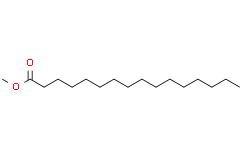Physicochemical Properties
| Molecular Formula | C17H34O2 |
| Molecular Weight | 270.4507 |
| Exact Mass | 270.255 |
| CAS # | 112-39-0 |
| Related CAS # | Methyl palmitate-13C16;Methyl palmitate-d31;29848-79-1 |
| PubChem CID | 8181 |
| Appearance | Colorless to white solid-liquid Mixture |
| Density | 0.9±0.1 g/cm3 |
| Boiling Point | 332.1±0.0 °C at 760 mmHg |
| Melting Point | 32-35 °C(lit.) |
| Flash Point | 152.8±7.5 °C |
| Vapour Pressure | 0.0±0.7 mmHg at 25°C |
| Index of Refraction | 1.441 |
| LogP | 7.62 |
| Hydrogen Bond Donor Count | 0 |
| Hydrogen Bond Acceptor Count | 2 |
| Rotatable Bond Count | 15 |
| Heavy Atom Count | 19 |
| Complexity | 190 |
| Defined Atom Stereocenter Count | 0 |
| SMILES | O(C([H])([H])[H])C(C([H])([H])C([H])([H])C([H])([H])C([H])([H])C([H])([H])C([H])([H])C([H])([H])C([H])([H])C([H])([H])C([H])([H])C([H])([H])C([H])([H])C([H])([H])C([H])([H])C([H])([H])[H])=O |
| InChi Key | FLIACVVOZYBSBS-UHFFFAOYSA-N |
| InChi Code | InChI=1S/C17H34O2/c1-3-4-5-6-7-8-9-10-11-12-13-14-15-16-17(18)19-2/h3-16H2,1-2H3 |
| Chemical Name | methyl hexadecanoate |
| Synonyms | Methyl hexadecanoate; Palmitic acid methyl ester; Hexadecanoic acid, methyl ester; Palmitic acid, methyl ester; Methyl n-hexadecanoate; Uniphat A60 |
| HS Tariff Code | 2934.99.9001 |
| Storage |
Powder-20°C 3 years 4°C 2 years In solvent -80°C 6 months -20°C 1 month |
| Shipping Condition | Room temperature (This product is stable at ambient temperature for a few days during ordinary shipping and time spent in Customs) |
Biological Activity
| ADME/Pharmacokinetics |
Absorption, Distribution and Excretion RETENTION & DISTRIBUTION OF (14)-CARBON ACTIVITY IN TISSUE LIPIDS AND FATTY ACIDS WERE DETERMINED 2 DAYS AFTER ADMIN OF (14)C-LABELED PALMITATE METHYL ESTER BY STOMACH TUBE. RETENTION WAS LOW IN YOUNG RATS WITHOUT ADIPOSE TISSUE. RETENTION IN THE BRAIN WAS FOUND AFTER 17 DAYS. THE HIGHEST LEVEL OF ACTIVITY WAS FOUND IN THE CARCASS. Biological Half-Life THE UTILIZATION OF (14)C-LABELED PALMITIC ACID BY RATS WAS DETERMINED BY THE LEVEL OF (14)-CARBON IN EXPIRED AIR AFTER ADMIN OF PALMITATE METHYL ESTER BY STOMACH TUBE. TWO SUCCESSIVE PEAKS IN THE OUTPUT OF LABELED CO2 OCCURRED, AT 3 & 18 HR. PALMITIC ACID ADMIN WAS ONLY HALF THE SIZE OF THE 1ST PEAK. THE 2 SUCCESSIVE PEAKS INDICATED A RECIRCULATION OF FATTY ACIDS IN THE RAT. T/2 OF THE LABELED PALMITIC ACID WAS 3 HR. |
| Toxicity/Toxicokinetics |
Interactions METHYL PALMITATE, AN INHIBITOR OF RETICULOENDOTHELIAL SYSTEM (RES) FUNCTION, INHIBITED BOTH THE RES FUNCTION & SERUM LYSOZYME INCREASES WHEN ADMIN TO GLUCAN TREATED MICE. GLUCAN-TREATED, ENDOTOXIN-SENSITIVE RATS ADMIN METHYL PALMITATE, A RETICULOENDOTHELIAL DEPRESSANT WHICH RENDERS RATS ENDOTOXIN RESISTANT, FOLLOWED BY SALMONELLA ENTERITIDIS ENDOTOXIN, RESULTED IN ENHANCED ELEVATION OF PLASMA GLUTAMIC OXALACETIC TRANSAMINASE & HYPOGLYCEMIA. THE VASCULAR REMOVAL & ORGAN UPTAKE OF INCOMPATIBLE SHEEP RED CELLS LABELED WITH CHROMIUM IN MICE WAS DECR DUE TO DECR VASCULAR CLEARANCE CAUSED BY FAILURE IN PHAGOCYTOSIS BY BOTH LIVER & SPLEEN AFTER ADMIN OF METHYL PALMITATE, A RETICULOENDOTHELIAL DEPRESSANT. THE ADMIN OF METHYL PALMITATE 100 MG/100 G, IV TO RATS CAUSED AN INCR IN SURVIVAL AT ENDOTOXIN DOSES OF 0.75 TO 3.0 MG/100 G. ALTHOUGH A MEAN 38% MORTALITY WAS CAUSED BY SALMONELLA ENTERITIDIS ENTOXIN 0.5 MG/100 G, IV IN NORMAL RATS , A 6-FOLD INCR OF THIS DOSE DID NOT CAUSE MORTALITY IN THE METHYL PALMITATE GROUP. METHYL PALMITATE, WHEN ADMIN TO GLUCAN-TREATED RATS, CAUSED NORMAL PHAGOCYTIC ACTIVITY IN THE PRESENCE OF RETICULOENDOTHELIAL SYSTEM HYPERTROPHY. For more Interactions (Complete) data for METHYL PALMITATE (8 total), please visit the HSDB record page. |
| References |
[1]. Anti-inflammatory and antifibrotic effects of methyl palmitate. Toxicol Appl Pharmacol. 2011 Aug 1;254(3):238-44. [2]. Depression of phagocytic activity and immune response by methyl palmitate. Am J Physiol. 1964 May;206:939-43. [3]. Methyl Palmitate, an Acaricidal Compound Occurring in Green Walnut Husks. Journal of Economic Entomology, Volume 102, Issue 1, 1 February 2009, Pages 196–202. |
| Additional Infomation |
Methyl palmitate is a fatty acid methyl ester. It has a role as a metabolite. Methyl palmitate has been reported in Camellia sinensis, Peperomia leptostachya, and other organisms with data available. |
Solubility Data
| Solubility (In Vitro) |
Ethanol : ~50 mg/mL (~184.88 mM) DMSO : ~50 mg/mL (~184.88 mM) |
| Solubility (In Vivo) |
Solubility in Formulation 1: 25 mg/mL (92.44 mM) in 10% DMSO + 90% (20% SBE-β-CD in Saline) (add these co-solvents sequentially from left to right, and one by one), suspension solution; with sonication. For example, if 1 mL of working solution is to be prepared, you can add 100 μL of 250.0 mg/mL clear DMSO stock solution to 900 μL of 20% SBE-β-CD physiological saline solution and mix evenly. Preparation of 20% SBE-β-CD in Saline (4°C,1 week): Dissolve 2 g SBE-β-CD in 10 mL saline to obtain a clear solution. Solubility in Formulation 2: ≥ 2.5 mg/mL (9.24 mM) (saturation unknown) in 10% DMSO + 90% Corn Oil (add these co-solvents sequentially from left to right, and one by one), clear solution. For example, if 1 mL of working solution is to be prepared, you can add 100 μL of 25.0 mg/mL clear DMSO stock solution to 900 μL of corn oil and mix evenly. Solubility in Formulation 3: 30 mg/mL (110.93 mM) in 50% PEG300 50% Saline (add these co-solvents sequentially from left to right, and one by one), suspension solution; with ultrasonication. Preparation of saline: Dissolve 0.9 g of sodium chloride in 100 mL ddH₂ O to obtain a clear solution. (Please use freshly prepared in vivo formulations for optimal results.) |
| Preparing Stock Solutions | 1 mg | 5 mg | 10 mg | |
| 1 mM | 3.6975 mL | 18.4877 mL | 36.9754 mL | |
| 5 mM | 0.7395 mL | 3.6975 mL | 7.3951 mL | |
| 10 mM | 0.3698 mL | 1.8488 mL | 3.6975 mL |
